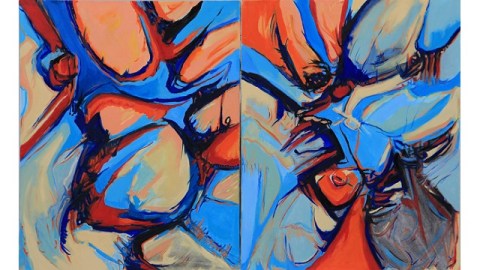Identity Theft: Seeing or Not Seeing Gender in Art

One of my favorite minor masterpieces in the collection of the Metropolitan Museum of Art is Young Woman Drawing (1801) by French master Jacques-Louis David. Or at least it was long thought to be by David. In the 1950s, experts believed that Constance Marie Charpentier, one of David’s women students, painted the work. Today, Marie-Denise Villers gets credit for the work. When David took credit, critics saw the hand of the master at work. When women entered the picture, suddenly the same painting lacked the qualities experts found previously. Beginning in March’s Women’s History Month, The Delaware Art Museum conducts an experiment in seeing gender in art in the exhibition Battle of the Sexes, in which visitors will vote on whether works were created by a female or male artist. The results may finally answer whether gender stereotypes in art are just another form of identity theft, in this case robbing female artists of the full identity of creator.
“Are masculine and feminine concepts fair game for either gender? And does the content or materials of our artwork have a ‘gender’?” asks M. H. Elcin, one of the artists in the show whose gender is currently hidden by the use of initials. “Although we don’t expect definitive answers to these questions, we hope this exhibition helps us start a dialogue with each other and our audience about gender equality and art.” Elcin may be one of the 13 female artists exhibiting who have each invited a male artist to exhibit with her. Results will be posted on the museum’s website on May 7th. Results will also be e-mailed to voters along with the actual genders of the artists, thus setting the stage for even more debate.
It’s a great thought experiment in revealing our prejudices to ourselves. I look at a work such as M.H. Pachnowski’s Cadmium Caribbean Diptych (shown above) and see the wondrous color associated with the close-to-the-surface emotions of female artists. And, yet, I also see the bravura brushwork associated with masculine power. The course of art history is littered with these gender associations. Pastels and watercolors were once the purview of women artists considered “too frail” for sculpture or oils. Macho art movements such as Abstract Expressionism dominated by hard-living, hard-drinking, and hard-painting figures such as Jackson Pollock seemed no place for a woman. In fact, one of the best (and most unjustly overlooked) female Abstract Expressionists, Grace Hartigan, actually once exhibited her work under the name “George Hartigan” just to sell paintings. Battle of the Sexes takes away the crutch of an artist’s name and reputation and forces us to see the work itself and “see” gender at work.
The ultimate aim of the show, of course, is to prove that we can’t “see” gender at all and simply project our prejudices onto the works in front of our eyes. The Met’s Young Woman Drawing’s price plummeted from David scale to Villers scale quite quickly, once again proving that women rarely get equal pay for performing the same work as men. Battle of the Sexes is a great beginning to a rejoining of the debate over how we subtly and, perhaps, unconsciously demote art created by women simply through applying the label of “female art.” Only by acknowledging that the true battle of the sexes is really a battle in our own head and against a tradition of gender-based bias will the battle for equal opportunities in subject matter and style for men and women be over.
[Image: M.H. Pachnowski (born 1949). Cadmium Caribbean Diptych, 2010. Oil on canvas, 20 x 16 inches each. Lent by the artist.]
[Many thanks to The Delaware Art Museum for providing me with the image above from and press materials for Battle of the Sexes, which runs through May 22, 2011.]





